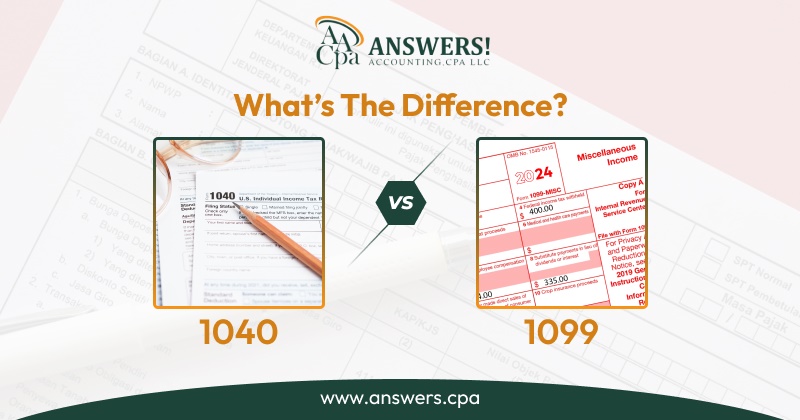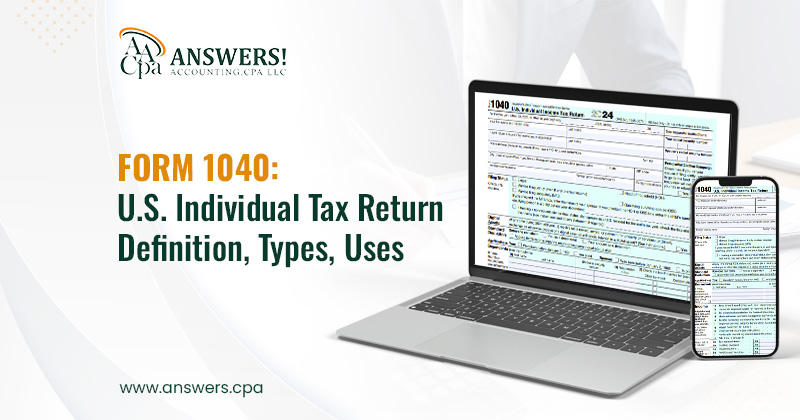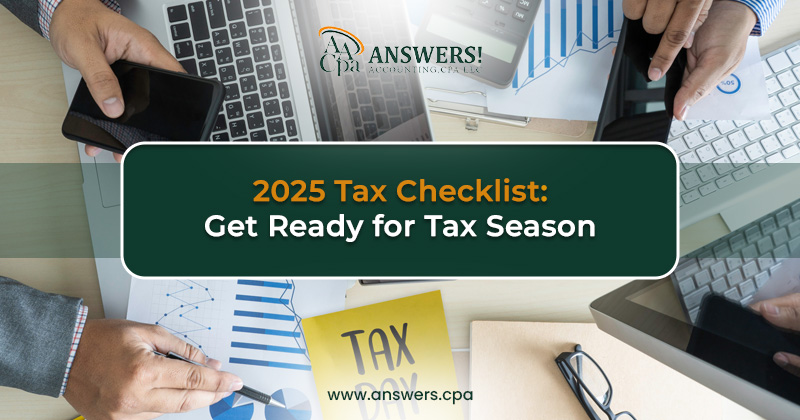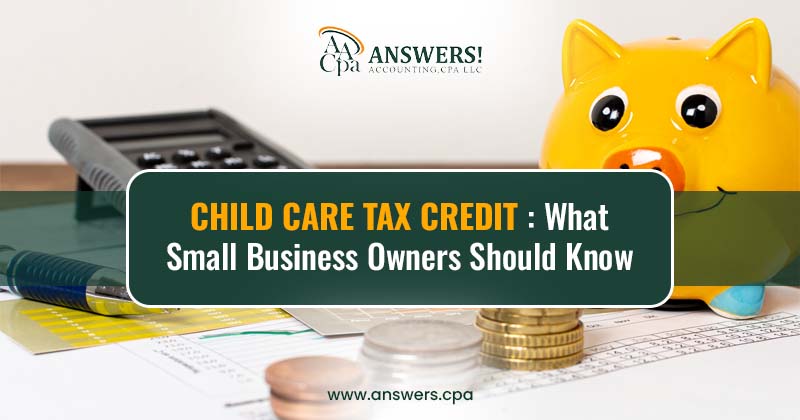1040 Vs 1099 Tax Forms: What’s The Difference?
When it’s time for tax season, knowing which forms apply to your situation is important. Form 1040 and Form 1099 are two common forms that individuals encounter. These forms have different functions and are used depending on how you generate money. Here, I will discuss what each form does, who should use them, and how to file them properly.
Let’s walk this through in plain and simple terms. You will be able to deal with your taxes no matter what means you make your income by reading this blog up until the end.
What is Form 1040?
In other words, it’s the U.S. Individual Income Tax Return which everyone in America fills out to report their yearly earnings to the IRS. You can calculate all of your total taxable income through this form and find out whether you owe any money or if they will give you a refund instead.
If you are employed and receive a W2 from your employer, it will show your gross monthly salary. Then, when filling out Form 1040, it's ok to proclaim that.
This document is important for the tax period. Almost all American taxpayers must complete it once in their lifetime. This applies regardless of their marital status or if they have children.
Key Facts About Form 1040
- • The form reports all your income sources: wages, interest, dividends, and other earnings.
- • You can claim deductions (such as the standard deduction or itemized deductions) to reduce your taxable income.
- • The form is also used to apply for tax credits that can reduce the amount of tax you owe.
- • Form 1040 is required for most tax filers, no matter their income type.
So, if you work a standard job and receive a W2 from your employer, you will file a 1040 federal tax return.
Read Blog- CPA Costs for Tax Preparation
Significance of Form 1040
The 1040 tax form is essential because it’s the main document that helps the IRS calculate how much tax you should pay or get refunded. Here’s why it matters:
- • It provides a complete overview of your financial situation for the year.
- • It allows you to claim tax deductions and credits that can lower your taxable income.
- • It’s used to figure out whether you owe the IRS more money or if you’ll get a refund.
- • It serves as the starting point for most people’s tax filing process.
In summary, 1040 is the centrepiece of your tax filing process if you earn regular income. It’s where everything starts and where you input all your financial details from the year.
What is Form 1099?
Online, your 1040 form, 1099, focuses on reporting income that is not salary-based. This implies that it does not encompass revenues generated from an ordinary job that comes with a paycheck. If you are a freelancer, contractor, or one who makes funds through other ways like investment, a 1099 will be sent to you.
The various types of 1099 forms exist for various processes. The most important form for freelancers and contractors is the 1099-NEC. It reports how much they earned from clients who hired them. Others, like banks, earn interest and dividends. This is shown by 1099-INT and 1099-DIV, respectively.
Key Facts About Form 1099
- • If you’re a contractor or freelancer, you’ll likely get a 1099-NEC to report income from your clients.
- • For people with investments, you’ll use other types of 1099 forms to report income from interest or dividends.
- • 1099 income doesn’t have taxes automatically withheld like regular wages do. You are responsible for paying those taxes on your own.
- • Freelancers and independent contractors need to set aside money for taxes since it’s not automatically deducted from their payments.
Significance of Form 1099
Form 1099 plays a crucial role for those earning non-wage income because it tracks income sources where taxes haven’t been withheld. This form alerts the IRS that you received payment, and you’ll need to account for it when filing your Form 1040.
Here’s why Form 1099 is significant:
- • It reports non-employee income, such as payments for freelance work or investments.
- • Since taxes aren’t taken out of 1099 payments, it’s up to you to estimate and pay your taxes (often through quarterly payments).
- • Properly managing 1099 income is key to avoiding underpayment penalties.
If you’re self-employed or have side gigs, Form 1099 will likely be part of your tax filing process.
Read This- Small Business Tax Planning Strategies
Difference Between Form 1040 and Form 1099
While both Form 1040 and Form 1099 are important, they apply to different types of income. Here’s a quick breakdown of the key differences between the two:
| Aspect | Form 1040 | Form 1099 |
| Purpose | Reports total income and calculates total taxes owed | Reports non-wage income (freelance, investments) |
| Income Type | Wages, salaries, tips (from W2), other earnings | Freelance payments, interest, dividends |
| Tax Withholding |
Employers withhold taxes from W2 income | No withholding, you pay taxes yourself |
| Who Uses It? | Regular employees, full-time workers | Freelancers, contractors, and investors |
| Filing Frequency | Filed annually to report all income sources | Filed when non-wage income is earned |
How to File Form 1040 and Form 1099
Filing Form 1040
Filing Form 1040 is a multi-step process, but it can be done with a bit of preparation:
- 1. Collect Your Documents: Gather your W2, 1099 forms, and any other tax-related documents (like receipts for deductions).
- 2. Report Income: Use the information from your W2 and other forms to report your total income.
- 3. Claim Deductions and Credits: Apply the standard deduction or itemized deductions. Don’t forget any tax credits you’re eligible for.
- 4. Calculate Your Tax Owed or Refund: Use the form to see whether you owe more taxes or will get a refund.
- 5. File the Form: You can e-file your Form 1040 through the IRS’s website or mail a paper copy.
Filing Form 1040 correctly is essential to ensuring that you pay the right amount of tax - or get the refund you deserve.
Filing Form 1099
If you receive a 1099 during the year, you’ll include that income when filing your Form 1040. Here’s how:
- 1. Collect All 1099s: Gather all 1099 forms you receive from different sources. These could be for freelance work, bank interest, or investments.
- 2. Report Non-Wage Income: Input the information from your 1099 forms on your Form 1040.
- 3. Pay Self-Employment Tax: If you’re self-employed, you may need to file Schedule SE to calculate and pay your self-employment taxes.
- 4. Consider Deductions for Business Expenses: If you’re a freelancer or contractor, you can deduct business-related expenses (like supplies or equipment) to lower your taxable income.
- Make Quarterly Payments: If you expect to owe more than $1,000 in taxes for the year, you may need to make quarterly payments to avoid penalties.
Filing Form 1099 income can be more complex, especially if you’re self-employed. It’s essential to track your income carefully throughout the year to ensure you’re filing correctly.
1040 or 1099: Which Tax Form Should You Use?
The form you use depends on the type of income you earn. Here’s a quick guide to help you decide:
- • Form 1040 is for anyone who earns wages, salaries, tips, and other income that’s typically reported on a W2. Most U.S. taxpayers will file Form 1040.
- • Form 1099 is used if you’re a freelancer, contractor, or someone who earns money from non-wage income. You’ll still file Form 1040, but you’ll include your 1099 income as well.
Many people receive both types of income. For example, if you work part-time for an employer but also do freelance work on the side, you’ll need to file a 1040 using information from both your W2 and 1099 forms.
What Tax Professionals Say About 1040 vs. 1099 Tax Forms
According to tax experts, one must understand the distinctions between these types of documents and their functions. Here is what they have to say:
- • Anyone who receives a monthly paycheck from an employer is required to fill out a 1040 form. It is clear-cut; hence, most individuals will only enter their W2 details.
- • In contrast, 1099 forms require greater attention and detail. For people earning non-wage income, it is necessary to monitor your earnings over the year and pay taxes accordingly.
- • Freelancers or contractors should make quarterly tax payments. Failure to do so attracts hefty fines during tax season.
Conclusion
The taxation process can be quite puzzling, however knowing what differentiates Form 1040 from Form 1099 could make it easier. This is especially helpful for employees and contractors. It ensures you file your taxes correctly and avoid penalties.
At Answers Accounting CPA, we have the expertise to help individuals and businesses fulfill their tax filing obligations. We can help with any issues with your federal 1040 tax return or your 1099 forms. Our experienced tax specialists will guide you through the process. We'll make tax season less stressful for you. Get started on your return now by contacting us and ensure you go correctly!
FAQ’s
- How is tax withheld from 1099 income?
Unlike W2 income, taxes are not automatically withheld from 1099 earnings. Freelancers and contractors are responsible for paying taxes themselves, often through quarterly payments.
- What is the main difference between Form 1040 and Form 1099?
Form 1040 is used to report total income and file taxes, while Form 1099 reports non-wage income like freelance work or investments.
- When should I make quarterly payments for 1099 income?
If you expect to owe more than $1,000 in taxes for the year, you may need to make quarterly tax payments to avoid penalties.
- Can I deduct business expenses on Form 1099?
Yes, freelancers and independent contractors can deduct business-related expenses to reduce their taxable income.
- What happens if I don’t report 1099 income?
Failing to report 1099 income can result in penalties, interest on unpaid taxes, and potential audits by the IRS.








